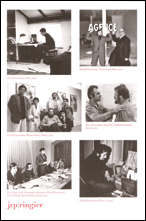 |
Harald Szeemann. «Individual Methodology.» 16th Session of the Ecole du Magasin, Grenoble. JRP|Ringier, 2007.
The choice of Harald Szeemann as the subject of the combined editorial efforts of the participants of the curatorial school at the Magasin in Grenoble seems self explanatory. After all, Szeemann practically invented the profession of independent curating and was the first to focus on exhibition spaces as one additional possibility to express subjective ideas. More than one of the spaces he sought out for his big, wild exhibitions – such as Hamburger Bahnhof or Deichtorhallen - have subsequently become established museums. Through several interviews, collected texts and documents by Szeemann himself and close collaborators, the aspiring curatorial candidate can infinitely learn about the organizational and financial hazards of self-produced shows. One also gains insight into the precarious equilibrium of constellations needed to fulfill the artists, the audience and the institution and the curatorial ego at the same time. A task one learns that even Szeemann, who has always been associated with curatorial practice as an authorial artistic notion, has considered impossible at times. I find this a truly consoling insight.
Owing to the number of authors, styles and variety of original sources, the book is at times tiresome to follow. Still, an interesting and largely untold story unfolds.
|